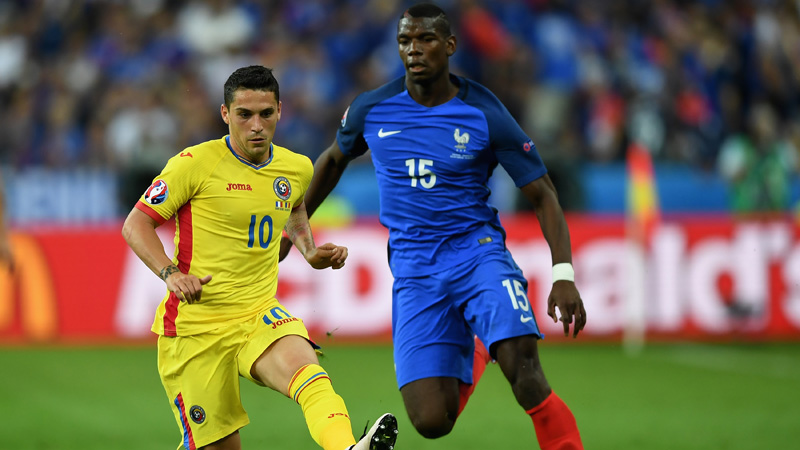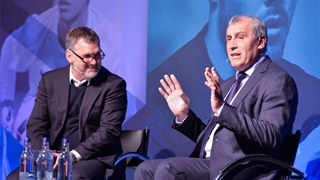
Dimitri Payet’s stunning 89th-minute winning strike will deservedly dominate the analysis of France’s narrow 2-1 victory against Romania in the opening game of Euro 2016.
And although Didier Deschamps' men were made to work hard for their victory, there were many encouraging signs for the hosts as Peter Glynn, FA Education Content Editor, discusses below.
France 2-1 Romania
UEFA Euro 2016
Group A
Friday 10 June 2016
Stade Saint-Denis, France
Live on BBC
1. French positional fluidity
It had been predicted that France would start the opening game of Euro 2016 with a 4-3-3 formation, with Arsenal’s Olivier Giroud flanked by Payet and Atletico Madrid’s Antoine Griezmann in attack.
In reality, the hosts’ rarely adopted that arrangement and when in possession showed encouraging signs of a fluid and flexible attacking strategy. Griezmann and, in particular, Payet – who was the game’s outstanding performer –were given licence to wander in opposition territory. It was only target-man Giroud who consistently held his position at the heart of the French frontline.
With Payet and Griezmann slipping into the pockets of central space between Romania’s defence and midfield in order to progress the play and penetrate the opposition, space was created in wide-areas for forward surges from full-backs Patrice Evra and Bacary Sagna who regularly operated as wingers.
It is an attacking trend expected to be adopted by many countries throughout the tournament.
Click here to see more details.
2. Payet the wandering creator
Rarely was the West Ham forward stuck regimentally to either flank. Instead, the 29 year-old - who scored nine times in his first full season in the Premier League – was empowered to satisfy his appetite for possession and moved anywhere and everywhere on the pitch in order to seek the ball.
This positional freedom was emphasised when Payet could be seen dropping into his own half to receive the ball from his back four, adopting the role of deep-lying playmaker in order to build the play.
However, it was from the pockets of space higher up the pitch between Romania’s defence and midfield that the former Marseille attacker inflicted most creative damage – including his late wonder strike.
Romania simply didn’t get to grips with his wanderings and were ultimately punished for not doing so, raising an interesting question for the remainder of the tournament: how do you combat an individual creative talent? Do you stay zonal or assign a man marker?
3. A big man, little man front pairing
With Payet given licence to roam, fellow attackers Giroud and Griezmann could be seen adopting a more structured forward arrangement and at times operated like a more traditional centre-forward pairing.
With Giroud’s strength and aerial abilities providing an outlet for intelligent and accurate direct balls into his frame, Griezmann was able to scheme around him. By having two sources of central attacking threat, France’s front pair ensured Romania’s backline were continually occupied and less likely to follow Payet into deeper areas.
4. Full-backs as wingers, and midfielders as full-backs
With France monopolising possession in central areas, full-backs Bacary Sagna and Patrice Evra took every opportunity to raid forward – regularly meaning Deschamps' men had five or six attackers strung across their frontline during attacking phases.
With space vacated by the full-backs’ forward runs, midfielders Paul Pogba and Blaise Matuidi could be seen moving into deeper wider areas in order to receive passes.
This meant on many occasions it was the wide midfield pair playing forward passes to the French full-backs who were in much higher attacking areas.
The advantage of Pogba and Matuidi beginning attacking moves from these areas was that they managed to find operating space away from the congestion of central midfield.

Nicolae Stanciu of Romania and Paul Pogba of France compete for the ball in the opening game of Euro 2016
5. Slide passes and forward runs
In the attacking third, France’s method of attack was to penetrate the opposition with intricately threaded passes and clipped forward balls behind the Romanian backline for the forward runs of Giroud and Griezman, as well as their attacking full-backs.
With Romania adopting a surprisingly high defensive line, Pogba and Payet were given the opportunity to demonstrate their full passing range including: slide passes between defenders; driven switches of play; and clipped curled passes from deep positions into spaces beyond the backline.
In particular, Juventus midfielder Pogba displayed a wonderful appreciation for perfectly-weighted threaded passes into the space between the central defender and full-back.
6. Playing out from the back: a more direct approach
Very rarely did France goalkeeper Hugo Lloris play short to his back four in order to retain the ball and build from the back. Instead, the Spurs keeper routinely aimed accurate direct balls into the opposition half.
Lloris aimed to locate the aerial prowess of Pogba – who often peeled out to the right-hand side of midfield when the goalkeeper was in possession – or the frame of Giroud at the tip of the hosts’ attack.
Although this approach meant possession was sometimes put at risk, Deschamps' side had the physical and combative qualities – particularly in midfield, where Leicester’s N’Golo Kante was flawless in his ability predict where the ball would drop– to ensure they were the first to react to any second-balls.
With possession secure in the opposition’s half the French attack was triggered to begin their fluid movement and intricate forward passing.
Peter Glynn is FA Education Content Editor and will be providing comment and analysis throughout Euro 2016.
Peter is editor of The FA’s coaching magazine, The Boot Room, and is a holder of the FA Advanced Youth Award and UEFA B coaching licence. Follow Peter on Twitter: @_peterglynn
*The views expressed in this article are those of the author and not necessarily The Football Association













